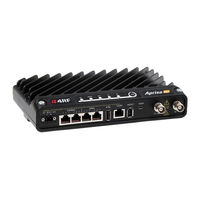4RF Aprisa SR+ Manuals
Manuals and User Guides for 4RF Aprisa SR+. We have 6 4RF Aprisa SR+ manuals available for free PDF download: User Manual, Product Description, Manual, Quick Start Manual
Advertisement
4RF Aprisa SR+ User Manual (403 pages)
Smart, secure, industry-leading speed licensed point-to-multipoint SCADA communications for industrial monitoring and control
Table of Contents
Advertisement
Advertisement





